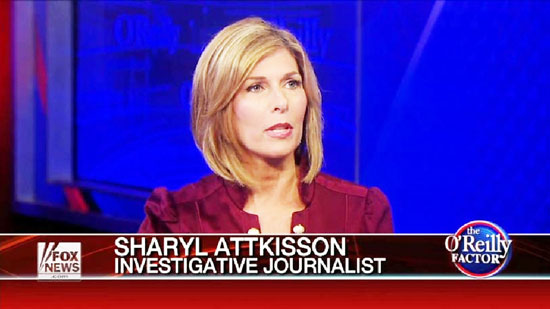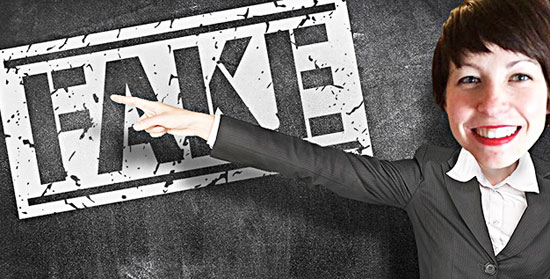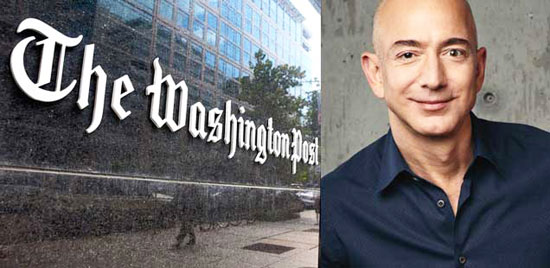Startling Evidence Indicates Funded Propaganda Campaign Responsible For War On Fake News

“Is ‘fake news’ real?” asked investigative journalist Sharyl Attkisson during a Tedx talk – posing the paradoxical question in the context of its explosion in popularity during the 2016 presidential election – or is the term, fake news, itself, a fabrication?
In its absurd extreme, identifiably fake news appears on supermarket shelves as tabloid magazines, in ‘reports’ on human births of alien hybrid babies and other blatant fabrications; while its more pernicious iteration, issued by traditional pillars of journalism – such as the New York Times and Washington Post, among many others – manifests in reports citing unsubstantiated sources and unnamed ‘officials,’ and often favors corporate sponsors as well as the political establishment.
Fake news isn’t new to the media landscape, in other words, but the catchphrase, as a descriptor, is.
Thus, what if fake news – peddled to the public as a pressing problem in need of solution – is itself a deception, intentionally constructed to silence legitimate critique, opposing viewpoints, and dissent?
Attkisson, who surmised the abrupt entrée of an artificial problem must have had assistance, investigated the origins of the phrase, ‘fake news,’ and its employment as accusation and insinuation, whether or not accompanied by substantiating evidence. And she was frighteningly on point.
“What if the whole anti-fake news campaign was an effort on somebody’s part to keep us from seeing or believing certain websites and stories by controversializing them or labeling them as fake news?” the seasoned journalist and winner of the Edward R. Murrow award for investigative reporting asks.
Weighing the evidence, timeline, and money trail Attkisson discovered – coupled with the resulting heavy-handed crackdown on social media and video-sharing platforms, as well as by search engines and advertisers, on the fictitious false information crisis – not only does it seem likely the term was premeditated and unleashed as a propaganda device, but as a loaded weapon inherently threatening to the future of the free press as protectively enshrined in the First Amendment.
With decades of experience, Attkisson’s hunch – that the specific term ‘fake news’ did not spread like acrid wildfire of its own volition – found factual corroboration.
In mid-September 2016, the nonprofit group, First Draft – funded in part, according to an archive of the site, by grants from the:
“John S. and James L. Knight Foundation, Open Society Foundation and the Ford Foundation, announced its mission to tackle malicious hoaxes and fake news reports.”
“First Draft, a project of the Shorenstein Center on Media, Politics and Public Policy at Harvard University’s John F. Kennedy School of Government – uses research-based methods to fight mis- and disinformation online. Additionally, it provides practical and ethical guidance in how to find, verify and publish content sourced from the social web,” the site’s About section states.
“The goal was supposedly to separate wheat from chaff,” Attkisson explains, “to prevent unproven conspiracy talk from figuring prominently in internet searches. To relegate today’s version of the alien baby story to a special internet oblivion.”
However innocuous-sounding that agenda, just one month passed before First Draft’s battle against fake news found a megaphone in the president, as Obama abruptly “insisted in a speech that he too thought somebody needed to step in and curate information of this wild, wild west media environment,” she notes.
But there hadn’t been a ruckus, much less a few lone voices, griping about fake news as an issue of any import – or even complaining, at all.
“Nobody in the public had been clamoring for any such thing,” Attkisson continues, “yet, suddenly, the topic of fake news dominates headlines on a daily basis. It’s as if the media had been given its marching orders.ˮ
“Fake news, they insisted, was an imminent threat to American Democracy.”
Aware “few themes arise” in the mass media environment “organically,” the seasoned investigator followed the money to First Draft’s funders – to discern which interested parties might be backing the rally against fake news.
Google, in fact, financed the group “around the start of the election cycle” – Google, whose parent company Alphabet’s CEO Eric Schmidt both acted as adviser and multi-million-dollar donor to the presidential campaign of Hillary Clinton.
Mirroring Obama’s lament, Clinton soon championed quashing fake news as a priority – and her “surrogate, David Brock of Media Matters, privately told donors he was the one who convinced Facebook to join the effort,” she adds.
“I’m not the only one who thought that the whole thing smacked of the roll-out of a propaganda campaign.”
Indeed, the nascent fake news allegation almost exclusively centered around conservative-leaning outlets, journalists, and articles perceived as favoring then-candidate Trump – and repeatedly alongside allegations those media entities were acting directly, indirectly, or haplessly at the behest of the Russian government – while the majority of the mud-slinging was levied without proof or the flimsiest of supporting evidence.
To wit, a succession of pieces published by mass media dispensed with the indispensable journalistic protocols of source – and fact-checking – then shied away from accepting responsibility for the incendiary and damaging claims once a furious backlash ensued.
Although Attkisson did not mention them specifically in the roughly ten-minute Tedx talk at the University of Nevada, two lists published at the height of the Fake News Scare – both of which were either republished or alluded and linked to by multiple corporate outlets – came into public purview under highly suspect circumstances, each lending albeit indirect credence to the hypothesis a propaganda crusade was underway.
On November 13, 2016, Merrimack College associate professor Melissa Zimdars out of the blue made public a Google document entitled, “False, Misleading, Clickbait-y, and/or Satirical ‘News’ Sources,” she later described as essentially a worksheet intended for colleagues and students to offer one another tips for avoiding disseminating fake news.
“So … I posted it to Facebook to my friends, you know, ‘Hey, media and communication people, if you think of other examples you come across,’” she explained of the list’s creation to USA Today College in an interview, “and so many of them sent me Facebook messages or comments and emails and I looked through them or through some of the people sent me blogs or other sources.”
Admittedly, without vetting whether or not each (or even a few) of the sites conjured from that Facebook post deserved a place on the inflammatory list, Zimdars committed the precise journalistic fraud putatively motivating its formation in the first place – as did the Los Angeles Times, whose piece, Want to keep fake news out of your newsfeed? College professor creates list of sites to avoid, let loose the unverified, unchecked, and unauthenticated aggregation, with its purely subjective guidelines, onto a populace stirred to frenzy over fake news, to expectedly viral results.

Critics and listees – many of which cogently included established if smaller conservative and pro-Trump outlets, as well as those covering the deluge of corruption allegations spawned from a series of leaks against then-candidate Clinton, John Podesta, and the Democratic National Committee – lambasted Zimdars, the Times, and other propagators for failing the integrity litmus test.
Slapped with requests for removal and a firestorm of fury, Zimdars temporarily revoked public access to the contentious list with vows to edit and update information as appropriate, and authored an editorial defense, appearing in the Post on November 18 2016, titled, “My ‘fake news list’ went viral. But made-up stories are only part of the problem.”
Despite the mayhem and arguable damage it caused to myriad legitimate sources listed among the obvious disinformation outlets, Zimdars’ list is once again open to the public on Google Docs.
After having established itself as a defender of the associate professor’s worksheet, the Washington Post took the L.A. Times’ lead, issuing an article on November 24 2016 almost wholly pertaining to a list it failed to embed or even link – only the name of the problematic organization, PropOrNot, provided clues for readers dedicated enough to search on their own. And they did in droves.
But the Post’s reckless foray into tabloidesque journalism – perhaps wary of negative perception beginning to foment against the anti-fake news brigade – crossed several lines demarcating standards of journalism; and weaved another narrative of equally dubious stature into the already unraveling anti-disinformation war: Russia.
“Russian propaganda effort helped spread ‘fake news’ during election, experts say,” the outlet proclaimed in the title for the article – whose un-accompanying blacklist pegged hundreds of independent, conservative, pro-Bernie Sanders, pro-Trump, and even left-leaning and award-winning sites as suddenly verboten due to direct or indirect Russian influence, or for acting as Russia’s “useful idiots” – all while vocally preserving the anonymity of the “four sets of researchers” responsible. Among them, PropOrNot.
“The flood of ‘fake news’ this election season got support from a sophisticated Russian propaganda campaign that created and spread misleading articles online with the goal of punishing Democrat Hillary Clinton, helping Republican Donald Trump and undermining faith in American democracy, say independent researchers who tracked the operation,” the piece’s lede contends. But, devoid named sources to question, transparency of methodologies, nor any other potentially mitigating factors which would have allowed independent verification contained in the original article, outrage this time included the Post’s competition.
In fact, several organizations listed as ‘allies’ by PropOrNot immediately disavowed the claim.
Eliot Higgins of research-focused Bellingcat, one of several entities named as such, tweeted that prior to the Post’s article, he had never heard of PropOrNot – incidentally indicating a lack of contact by reporters from the media organization – and, further, he “never gave permission to them to call Bellingcat ‘allies.’”
Fortune’s Mathew Ingram penned an incredulous response, entitled, “No, Russian Agents Are Not Behind Every Piece of Fake News You See.” Effectively destroying every facet of the Post’s anathema piece, Ingram pointed out there is:
“Also little data available on the PropOrNot report, which describes a network of 200 sites who it says are ‘routine peddlers of Russian propaganda,’ which have what it calls a ‘combined audience of 15 million Americans.’ How is that audience measured? We don’t know. Stories promoted by this network were shared 213 million times, it says. How do we know this? That’s unclear.”
Ultimately forced into addressing the resulting chaos, the Washington Post article eventually bore a note from the editor, not a retraction, asserting [with emphasis added]: “The Washington Post on Nov. 24 published a story on the work of four sets of researchers who have examined what they say are Russian propaganda efforts to undermine American democracy and interests.
One of them was PropOrNot, a group that insists on public anonymity, which issued a report identifying more than 200 websites that, in its view, wittingly or unwittingly published or echoed Russian propaganda.
A number of those sites have objected to being included on PropOrNot’s list, and some of the sites, as well as others not on the list, have publicly challenged the group’s methodology and conclusions.
The Post, which did not name any of the sites, does not itself vouch for the validity of PropOrNot’s findings regarding any individual media outlet, nor did the article purport to do so.
Since publication of The Post’s story, PropOrNot has removed some sites from its list.”
To reiterate, the Post did not retract the article abruptly conflating fake news with Russian propaganda – regardless the brazen if planned distancing of itself from the content therein – and has never divulged its justification for publishing such threadbare work, nor for allowing the empty allegations to remain available for the world to read online in perpetuity.
On January 8, 2017, amid continued outrage over specious and vapid fake news and Russian propaganda accusations, Washington Post columnist Margaret Sullivan declared the entirety of the outlet’s relentless anti-fake news jihad null, titling an article, “It’s time to retire the tainted term ‘fake news’” positing the term’s mere months long duration may have served a purpose at its advent, but “its meaning already is lost.”
Attkisson notably emphasizes, however, the term never imparted a steel definition nor universally agreed-upon guidelines delineating precisely what it constitutes.
That ambiguity disputably explains placing the term front and center in a propaganda campaign – as it is sharply suggested by Attkisson’s funding investigation of First Draft with bulk of the aforementioned body of evidence – for doubt before persuasion wields power.
For its irresponsible reporting of the unsubstantiated blacklist, false claims Russia had hacked into Vermont’s power grid, and all-out push to – for all intents and purposes – vilify or discredit opposing but legitimate viewpoints, the Washington Post and its controversial owner Jeff Bezos, also CEO of Amazon, garnered praise from failed presidential candidate Hillary Clinton, who professed without a hint of irony to an audience May 31, 2017, at the annual Code Conference, as quoted by CNBC:
“I think Jeff Bezos saved The Washington Post. But newspapers, like the Post, the Journal, the Times, others – still drive news. … It was a very good use of his financial resources. Because now we have a very good newspaper again operating in Washington, and driving news elsewhere.”

All bold tit-for-tat back-patting aside, Clinton’s adoration for an ostensive news organization, which displayed an egregious lack of journalistic standards on several occasions might be only telling, were the audacious effort to mute dissenting and critical voices – who had reported factually on damning evidence of layers of corruption plaguing the former secretary of state’s campaign, officials, and party as divulged by Wikileaks – not also tandemly gaining momentum.
It has been theorized the work of journalists not employed by traditional, corporate mass media organizations had – in wading through the vitriol of election season to report the avalanche of information dumped in leaks and pivotal to outcome, yet ignored by mass media – assisted in stoking rage against the establishment and was responsible for the concurrent astronomical success of the Sanders campaign, to the detriment and consternation of Clinton.
Whether or not that hypothesis holds weight, that responsible reporting picked up mainstream’s slack, as the big-name outlets instead trained their audiences’ attentions on questioning Wikileaks, whistleblowers, and similar diversions.
In short, the widely-varied body of independent media became essential for the dissemination of accurate information.
But that vitality, under the vacuous premise of combating fake news, is being strangled by oppressive social media algorithms, yanked advertising and sponsor dollars, and other tactics perhaps comprising the truer imminent threat to vestiges of democracy: censorship, through suppression and omission, of a free press.
This debilitating loss – the neutering of media still upholding its duty to question government and report facts for their own sake – to a concerted effort to solve the manufactured fake news problem would be irrevocable tragedy.
Attkisson – a noted dissenting voice, critical of lapdog media, herself – stopped short of a definitive conclusion regarding a coordinated propaganda campaign, warning:
“What you need to remember is that when interests are working this hard to shape your opinion, their true goal might just be to add another layer between you and the truth.”
yogaesoteric
June 11, 2018
